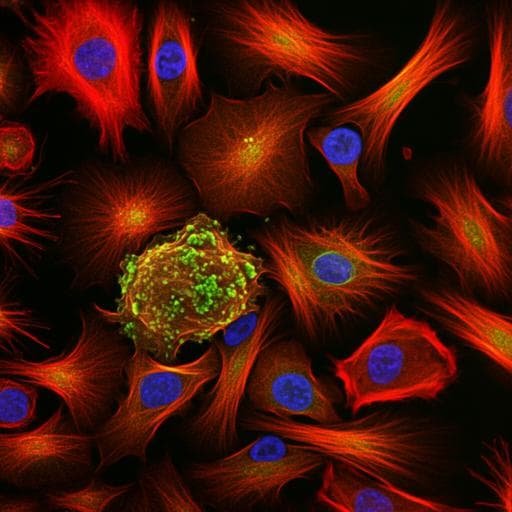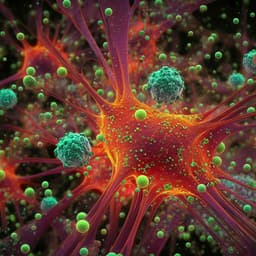
Veterinary Science
Single-cell RNA sequencing reveals the cellular and molecular heterogeneity of treatment-naïve primary osteosarcoma in dogs
D. T. Ammons, L. S. Hopkins, et al.
Discover groundbreaking insights into osteosarcoma, an aggressive bone cancer, through single-cell RNA sequencing in treatment-naïve dogs. This research, conducted by Dylan T. Ammons, Leone S. Hopkins, Kathryn E. Cronise, Jade Kurihara, Daniel P. Regan, and Steven Dow, reveals 41 distinct cell types and underscores the translational potential of canine models in immuno-oncology.
~3 min • Beginner • English
Introduction
Osteosarcoma is an aggressive primary bone malignancy with limited therapeutic advances since combined surgery and adjuvant chemotherapy were introduced in 1986. Its rarity hampers clinical trial accrual, and the complex, immunosuppressive tumor microenvironment obstructs effective antitumor immunity. Spontaneously occurring canine OS is a valuable, immunocompetent large-animal model due to its higher prevalence and shared genetics and pathology with human OS, but species-specific reagent limitations have impeded detailed characterization of the canine OS TME. Prior human scRNA-seq studies have charted OS landscapes. The study’s objective was to use scRNA-seq to dissect the canine OS TME in treatment-naïve primary tumors and evaluate transcriptomic homology of cell types between canine and human OS.
Literature Review
The background highlights slow therapeutic progress in OS and the need to understand the immunosuppressive TME. Prior reports in human and canine OS suggest increased macrophage abundance may correlate with reduced metastasis and better survival, though findings across studies are conflicting. scRNA-seq has emerged as a tool overcoming species-specific reagent limitations and has been applied to human OS to define primary, recurrent, and metastatic landscapes. The canine model is emphasized as translationally relevant, with similarities in disease biology to human OS but lacking comprehensive canine-specific immune cell signatures. These gaps motivate single-cell dissection of the canine OS TME and cross-species comparisons.
Methodology
Study design and samples: Primary tumor samples were collected from 6 treatment-naïve dogs with appendicular OS immediately following limb amputation (within 30 minutes). Histopathology confirmed OS and subtyping (1 fibroblastic, 1 chondroblastic, 4 osteoblastic); one dog had radiographic lung metastasis. Ethics approvals and owner consent were obtained.
Tissue processing: Tumor cores were obtained via trephine, minced, and digested with collagenase II. Following filtration and washes, viable cells were enriched using Ficoll density centrifugation, RBC lysis (ACK), and debris/platelet removal. Cells with >90% viability were loaded on Chromium iX (10x Genomics).
Library prep and sequencing: Chromium Next GEM Single Cell 3′ v3.1 libraries were prepared with a target of 5,000 cells per sample (two dogs with two captures each). Libraries were sequenced on Illumina NovaSeq 6000 (150 bp paired-end), targeting 100,000 reads per cell.
Read processing: Cell Ranger v6.1.2 aligned reads to CanFam3.1 (Ensembl r104) to generate count matrices.
QC and integration: Cells were retained if 200 < nFeature_RNA < 5500, percent mitochondrial < 12.5, and 100 < nCount_RNA < 75,000. Doublets were removed with DoubletFinder. Samples were normalized with SCTransform and integrated using Seurat’s anchor-based workflow (2000 anchors), regressing percent mitochondrial reads. Ideal clustering parameters: resolution 0.8, 45 PCA dims, n.neighbors 40, min.dist 0.35. UMAP was used for visualization. Three low-quality clusters were removed and integration repeated.
Major population identification and subclustering: High-level clusters were annotated using canonical markers, human OS reference mapping, SingleR, and GSEA. Subclustering was performed separately on tumor/stroma, T cells, dendritic cells, and macrophage/osteoclasts with tailored integration and clustering parameters (e.g., tumor/stroma res 0.5, dims 40; T cells res 0.6, dims 40; DCs res 0.3, dims 35; macrophage/OC res 0.6, dims 40). Additional low-quality/doublet clusters were removed.
CNV inference: CopyKAT (cells with >2000 UMIs) and inferCNV were used to distinguish aneuploid malignant cells from diploid stromal cells, enabling separation of malignant osteoblasts from fibroblasts.
Differential expression and pathway analysis: Pseudobulk DGE used DESeq2 after filtering low-abundance features; significance thresholds were adjusted P < 0.05 and |log2FC| > 0.58. GSEA used clusterProfiler and msigdbr; additional cluster-level competitive GSEA used singleseqgset with FDR correction.
Regulon analysis: Gene symbols were ortholog-mapped to human (orthogene). pySCENIC/SCANPY pipelines inferred regulon activity and regulon specificity scores (AUCell) using human cistarget resources.
Cell-cell interactions: CellChat inferred ligand-receptor networks on the full 41-cell-type atlas and an immune-only subset. Gene symbols were ortholog-mapped to human prior to analysis. Networks were categorized as immune, immune-related, or non-immune; specific immune-regulatory networks (PD-L1, CD80/CD86) were examined.
Cross-species comparison: Six treatment-naïve human OS scRNA-seq datasets (GSE162454) were processed with matching QC parameters and integrated with the canine dataset using Seurat (3000 anchors). Hierarchical clustering and Jaccard similarity indices assessed cross-species cell type relationships. Signed adjusted P value comparisons from within-species DGE contrasts evaluated conservation of transcriptional programs (e.g., fibroblast vs endothelial, pDC vs cDC2, mature OC vs monocyte/TIM).
Data summary: In total, 35,310 cells (average ~5,885 per tumor; average depth ~72,649 reads/cell) were analyzed. Initial clustering identified T cells, B cells, TIM/TAMs, DCs, osteoclasts, tumor cells, cycling tumor cells, neutrophils, mast cells, endothelial cells. Composition: ~42.3% tumor cells/fibroblasts, ~2.1% endothelial cells, ~55.6% immune cells.
Key Findings
- Comprehensive atlas: Identified 41 transcriptomically distinct cell types across 35,310 single cells from 6 treatment-naïve canine primary OS tumors.
- Tumor and stroma: CNV inference distinguished malignant osteoblasts from stromal fibroblasts, revealing 9 malignant osteoblast populations (including hypoxic and an IFN-response osteoblast cluster) and one fibroblast cluster with strong EMT and angiogenesis signatures. Fibroblast markers included SFRP2 and PRSS23, suggestive of wound-healing fibroblasts.
- T/NK compartments: Ten T/NK clusters including activated CD4 T cells, Tregs (CTLA4, FOXP3; overexpression of IL21R, TNFRSF4, TNFRSF18), cytotoxic/exhausted CD8 T cells, cycling T cells, NK cells, and a CXCL13+ follicular helper-like CD4 subset (CD4fh; CXCL13, IL21, TMEM176A) conserved with human reports. Effector and exhausted CD8 T cells were among the most abundant lymphocyte populations.
- Dendritic cells: Five DC subtypes (cDC1, cDC2, pDC, preDC, mregDC). mregDCs displayed a mature, migratory, and regulatory signature (CCR7, IL4I1, CCL19, FSCN1) consistent with human mregDCs. pDCs expressed high TLR7/TLR9; preDCs resembled plasmacytoid-like preDCs described in humans.
- Macrophage/monocyte spectrum: Eight TAM/TIM populations spanning activated TAMs, intermediate TAMs, IFN-TAMs, angiogenic TAMs, two lipid-associated TAMs (LA-TAM_C1QC high and LA-TAM_SPP2 high), and CD4+ vs CD4− TIMs (a dog-specific monocyte division). C1QC LA-TAMs showed the strongest anti-inflammatory signature (APOE, IGF1, C1QA/B/C), while CD4+ TIMs showed the strongest pro-inflammatory signature (IL1B, S100A12, LTF, VCAN). GSEA indicated oxidative phosphorylation/mitochondrial pathways in SPP2 LA-TAMs and intermediate TAMs; lipid/polysaccharide metabolism in C1QC LA-TAMs; IFN signaling in IFN-TAMs.
- Osteoclasts: Four OC populations identified, including cycling/pre-progenitors, mature OCs (ATP6V1C1, CD84, HYAL1, CAMTA2; linked to bone resorption), and a distinct CD320+ OC population (HMGA1, TNIP3, CD320; enriched RANK relative to macrophages), potentially an OC precursor. Regulon analysis highlighted NFATC1/ZEB1 in mature OCs and SNAI1/ETV family factors in CD320+ OCs.
- Cell-cell communications: Across 59 signaling networks and 13,235 inferred interactions, fibroblasts, mature OCs, and endothelial cells had strong overall communication. Immune-specific networks highlighted TAMs and DCs as dominant senders; mregDCs and IFN-TAMs had many immune-regulatory interactions. Predicted PD-L1 and CD80/CD86 interactions connected mregDCs/TAMs with Tregs, naive CD4 T cells, and exhausted CD8 T cells, suggesting myeloid modulation of T cell immunity.
- IHC marker specificity: Transcript-level analysis showed variable specificity of common macrophage markers: CD163 was most macrophage-specific; CD68 was expressed in TIMs, TAMs, and highly in mature OCs; AIF1 (Iba1) was broadly expressed; MSR1 (CD204) was largely TAM-specific but present in CD320+ OCs and CD4+ monocytes. Similar variability was observed in human OS data.
- Cross-species conservation: Integration with 6 human OS datasets showed high conservation of cell type signatures, particularly for lymphocytes, endothelial cells, and fibroblasts. Differences were noted for pDCs and mast cells (lower Jaccard similarity), and for certain monocyte features (e.g., canine SLAMF9/PLBD1 vs human S100A8/HCST).
Discussion
The study addressed the need to map the canine OS TME at single-cell resolution and to compare it with human OS. Findings demonstrate extensive cellular and transcriptional heterogeneity within malignant osteoblasts and myeloid compartments, and identify key immune-regulatory cell types (mregDCs, specific TAM states) and their predicted interactions with T cell subsets (Tregs, CXCL13+ CD4 follicular helper-like cells, exhausted CD8 T cells). These results illuminate mechanisms by which myeloid cells may shape T cell-mediated immunity in OS through PD-1/PD-L1 and CTLA4-CD80/CD86 axes. The discovery of distinct TAM states, including lipid-associated subsets with immunosuppressive and metabolic features, refines the understanding of macrophage roles in OS and may reconcile conflicting clinical correlations by highlighting marker specificity and myeloid heterogeneity. Cross-species analyses reveal strong conservation of cell type programs between dogs and humans, supporting the translational value of the canine model, while pinpointing differences in pDCs, mast cells, and monocyte signatures that warrant further study. The atlas and derived gene signatures provide a foundation for reagent development, biomarker discovery, and functional interrogation of OS immunity.
Conclusion
This work delivers a comprehensive scRNA-seq atlas of treatment-naïve canine primary osteosarcoma, defining 41 cell types, detailed T, DC, TAM, and OC states, and a distinct fibroblast population. It identifies conserved mregDCs and CXCL13+ CD4 follicular helper-like T cells in canine OS, reveals immunoregulatory myeloid–T cell interaction networks, and highlights variable specificity of commonly used macrophage IHC markers. Cross-species integration shows substantial conservation between canine and human OS TMEs, validating the dog as a translational model while revealing species-specific differences in certain immune cell types. Future directions include validating candidate surface markers and interactions at the protein/spatial level, refining IHC panels and incorporating spatial transcriptomics, functionally characterizing TAM and OC subpopulations (including CD320+ OCs), and leveraging gene signatures for bulk deconvolution and immunotherapy stratification.
Limitations
- Sample size: Only 6 biological replicates; may not capture full OS TME diversity.
- Sampling skew: One dog showed disproportionately high neutrophils, possibly from blood/bone marrow/necrotic tissue contamination.
- Annotation dependencies: Cell annotations relied heavily on human-derived gene signatures due to limited canine resources, potentially exaggerating cross-species similarity and forcing canine-specific cell types into human-based categories.
- Transcript-to-protein gap: Marker evaluations and interaction inferences are based on transcript abundance; protein expression and functional interactions require validation.
- Cross-species discrepancies: Notable differences in pDCs, mast cells, and monocytes suggest species-specific programs that need further investigation.
Related Publications
Explore these studies to deepen your understanding of the subject.







